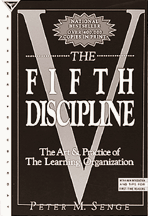The Fifth Discipline: The Art and Practice of the Learning Organization
The Fifth Discipline: The Art and Practice of the Learning Organization by Peter Senge (423 pages, Currency Doubleday)
(originally published by Booz & Company) Senior executives are devoting more of their time these days to fostering a culture of learning within their organizations. They realize that many of the recurring problems they deal with would be more quickly and productively resolved if they managed and belonged to a learning organization. Peter Senge's The Fifth Discipline: The Art and Practice of the Learning Organization, out in a new edition to mark its fifth anniversary, remains the seminal book about the value of creating such a company.
Senior executives are devoting more of their time these days to fostering a culture of learning within their organizations. They realize that many of the recurring problems they deal with would be more quickly and productively resolved if they managed and belonged to a learning organization. Peter Senge's The Fifth Discipline: The Art and Practice of the Learning Organization, out in a new edition to mark its fifth anniversary, remains the seminal book about the value of creating such a company.
The author, the director of the Center of Organizational Management at the Sloan School of Management at the Massachusetts Institute of Technology, steps back from the problems facing large and small companies alike and convincingly asserts that many of these problems exist because organizations simply do not adapt well to changing circumstances. This "hard to turn an oil tanker" mindset entraps companies because they lack several critical capabilities (or as the author would put it, they are dysfunctional). In short, they are not learning organizations. Put another way, they are slow to improve.
The author describes the five components needed to build a learning organization: systems thinking, personal mastery, mental models, building a shared vision and team learning.
Senior management will find three of these (systems thinking, mental models and team learning) of the most practical interest for putting the fundamentals of a learning organization in place.
With regard to systems thinking, Professor Senge lays out a clear case that sustained performance improvement can be achieved only by seeing and managing interrelations (in the business and in the organization), rather than by asserting and hoping for linear cause and effect. This need to see business and organizations as systems, with interrelated parts and complicated "wiring," reflects oft-expressed senior management concerns about getting those parts to move in unison.
Using pragmatic business and non-business examples, the author also points out the problems caused by failing to see underlying trends. As a remedy, he provides ideas that companies can use to develop the ability to see processes of change.
The mental model is a powerful concept that explains how processes of change so often fail to achieve their intended impact. The central issue is that while managers may understand that specific changes are required, these changes and the actions necessary to achieve them conflict with long-held mental models that have served individuals well in the past. The author quotes Einstein to add context to the concept: "Our theories determine what we measure." Professor Senge goes on to give examples of companies helping managers develop and refresh their mental models, including Shell's well-known planning approach that has allowed executives there to succeed in a notoriously volatile business.
Team learning essentially involves changing the personal behavior of managers as they interact across the organization. This section of the book was particularly inviting to me because my own mental models are overloaded with management behavior theories (theory X, theory Z, MBWA, etc.). A pleasant surprise is the author's able description of how to begin changing behaviors to foster team learning and to reinforce the positive changes necessary to achieve a learning organization.
Throughout the book, Professor Senge demonstrates the value of the learning organization as the most sustainable means for achieving superior financial performance. He also shows how to build the components of such an organization. But the linkages between those components, which are arguably as important as the components themselves, are sometimes left for the reader to discern.
Indeed, the reader must work hard in other places, too, to make conceptual and practical linkages as well as to overcome leaps in the discussion from sometimes trite examples (supported by 1950's vintage graphics) to heavy conceptual discourse. In addition, the text is a bit too long, as when the author addresses topics that are not essential to the core concept. The chapter on "ending the war between work and family" is one example.
Still, this is a very useful book for senior managers because it addresses many of the problems they face in moving their companies forward. Though it may be slow going at times, it is a very worthwhile first step toward building a learning organization. ![]()


